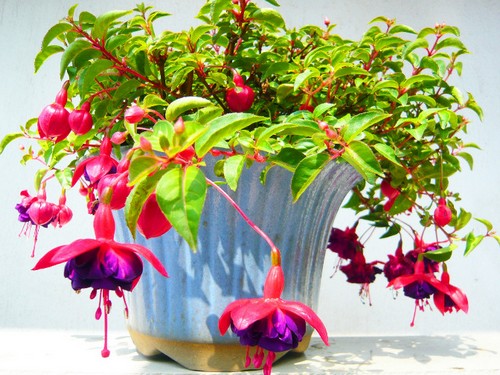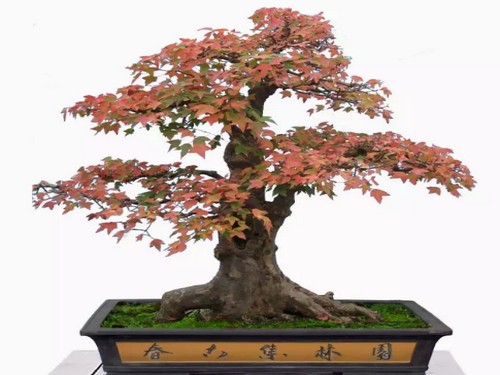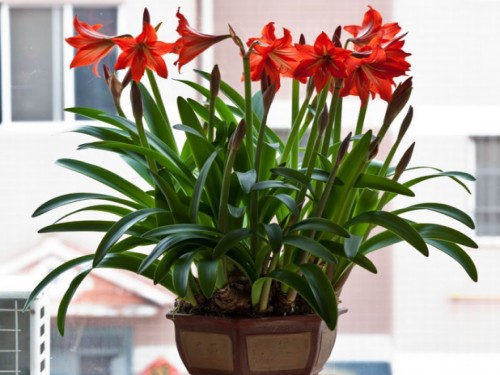Culture method of potted bell flower
In the case of potted plants, in order to prevent the soil from drying and avoid direct light, it should be cultivated in a sunny to half-sunny place. Especially when it is hot in summer, you should avoid direct sunlight and afternoon sunlight, and try not to be exposed to the sun if you can. Deciduous leaves in winter, strong cold resistance, so there is no need for special cold prevention measures.

The flower of the bell flower is numerous and dense, and the large plant can blossom more than 1000; the flower color is bright and the flowering period is long, which is a kind of ornamental flower favored by the public. Next, we will talk about the breeding methods and maintenance points of the bell flower.
Soil: the substrate of potted bell flower should be cultivated with fertile, loose and well-drained soil. generally, rotten leaf soil and Gaza loam soil can be evenly mixed with rotten organic fertilizer and phosphate fertilizer, without the need to apply base fertilizer to avoid rotting roots. The clayey and heavily consolidated soil is disadvantageous to the growth of the bell flower, and it is not suitable for the seedlings that have just survived cuttage.
Lighting: although the bell flower likes the shade, it does not mean that it does not need sunlight. In the absence of sunlight, it is not only easy to grow, but also causes the flower color to fade and the flower to become smaller or even drop its buds. Therefore, in the process of planting bell flowers in the family, they can be placed on a sunny balcony or terrace for photosynthesis.
Temperature: the growth temperature of the bell flower is 10 ℃ 28 ℃, and the summer temperature should not exceed 30 ℃, so we should do a good job of cooling in summer. Sufficient sunshine is required in winter, and the temperature of the culture soil should not be lower than 5 ℃, otherwise it will cause frost damage and heat preservation measures must be taken. In addition, we should pay attention to ventilation in both winter and summer.
Watering: the bell flowers should be watered according to the principle of dry and wet. In dry spring and hot summer seasons, you can spray water on the branches and leaves twice a day. If you water too much, it will cause stagnant water in the basin soil. If the room temperature is low in winter, watering should be strictly controlled and fertilization should be stopped to prevent rotting roots. Loosen the soil in time after each fertilization and watering to facilitate ventilation.
Fertilization: because the bell flower grows fast and blossoms many times, it is necessary to apply thin fertilizer frequently during the growth period, applying thin cake fertilizer or compound fertilizer about every 10 days, and applying liquid fertilizer mainly based on phosphorus and potassium once a month during flowering, but stop fertilizing in high temperature season. The basin soil should be dry before fertilization, and spray water with fine sprinkler once after fertilization to avoid leaf rot.
Pruning: the best time for pruning is after flowering. Because the flower buds that bloom in the second year grow in summer, the flower buds will be cut off after pruning, which is bound to reduce the number of flowers in the second year. If a large degree of pruning is carried out in an appropriate period, it will not have a great impact on the flowering of the following year.
Key points of maintenance:
Chimonanthus likes to be rich in humus and slightly acidic sandy loam with good drainage, and the clayey soil is disadvantageous to its growth, let alone the seedlings that have just survived by cutting.
During the growth period, cool climate is required, and 10Mel 15 ℃ is suitable; sufficient sunshine is required in winter, which can withstand the low temperature of 3Mel 5 ℃; in summer, it is in a state of semi-dormancy, avoiding heat and preferring half shade. The south needs shade from May to October, and the temperature grows most rapidly when the temperature is 15 ℃ and 23 min.
The key to the cultivation technique is to make the hanging bell flower spend the summer safely. When the air temperature rises to 30 ℃, it is disadvantageous to its growth. Cooling measures should be taken, which can be placed in a ventilated shade, but Rain Water can also be short pruned to avoid getting wet.
Stop fertilizing in summer and control watering to make it dormant gradually. After flowering, when the leaves begin to turn yellow, prune, leaving only the base 20 cm, so that it sends new branches, which is conducive to the safety of the summer. The bell flower is afraid of waterlogging, and the seedlings on the pot can not use too large flowerpots at the beginning, so as to avoid poor drainage and soil waterlogging and death. Only with the growth of the plant, gradually replace the larger flowerpot.
Time: 2019-06-01 Click:
- Prev

Cultivation and maintenance of bonsai of Acer truncatum
Planting methods are potted, planted on the ground, and built with bricks to build ponds. All kinds of planting methods have their own characteristics, and each person's situation is different and should be treated separately. The tall, strong and powerful body and the domineering root plate all reflect the majestic beauty and seductive momentum of the triangular maple, which is one of the most elegant tree species.
- Next

Culture methods and matters needing attention of potted Zhu Dinghong
Zhu Dinghong is a very popular potted plant in home beautification. With its large flowers, peculiar flowers, many colors and a wide variety, Zhu Dinghong is a very rare variety of flowers, and the breeding industry is relatively simple. From the above summary of Zhu Dinghong culture methods can also be seen.
Related
- Fuxing push coffee new agricultural production and marketing class: lack of small-scale processing plants
- Jujube rice field leisure farm deep ploughing Yilan for five years to create a space for organic food and play
- Nongyu Farm-A trial of organic papaya for brave women with advanced technology
- Four points for attention in the prevention and control of diseases and insect pests of edible fungi
- How to add nutrient solution to Edible Fungi
- Is there any good way to control edible fungus mites?
- Open Inoculation Technology of Edible Fungi
- Is there any clever way to use fertilizer for edible fungus in winter?
- What agents are used to kill the pathogens of edible fungi in the mushroom shed?
- Rapid drying of Edible Fungi

